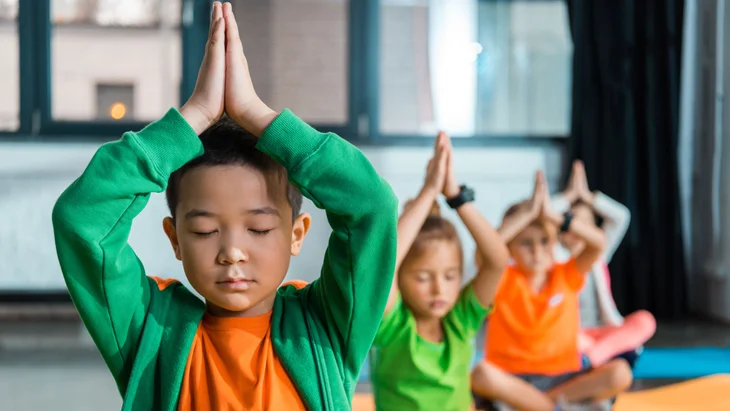Body Awareness Education Through Yoga Teacher Training

Body awareness is a fundamental aspect of yoga practice. It is important for students to understand the abilities of their bodies in order to be safe and effective during yoga classes.
Body awareness includes proprioception and kinesthesia. Qualitative studies suggest that yoga can improve sensory and interoceptive body awareness [14].
Mind-Body Connection
Yoga provides a holistic experience that helps you connect with your physical body. Body awareness is important to understand during yoga because it can help you stay safe and protect yourself as you practice. It is also a great way to become aware of your emotional and mental well-being. In fact, it’s recommended to use yoga as part of your treatment program for mental health or addiction recovery.
The mind-body connection is the feedback loop between your thoughts and feelings. It is a common misconception to think that your emotions are separate from your physical body, but this couldn’t be further from the truth. Your emotions are a physical sensation and they can be interpreted by your nervous system.
When you are feeling anxious, your heart rate will increase. If you are angry, your posture will change and you may clench your jaw. Your brain sends these signals to your body and to your other internal organs, so it is vitally important that you listen and observe your body when you are feeling a certain emotion.
Our 200 hour Yoga Teacher Training focuses on integrating an understanding of the human body and its capabilities into your yoga practice. Through our Embodied Posture Method, you will learn to align yoga poses to suit your unique needs and abilities.
Stress Reduction
Stress is an emotional and physical experience that can be caused by a wide range of factors. It may come from relationships, work, financial difficulties, or health issues. It can lead to feelings of anxiety, irritability or low self-esteem. These feelings can make it difficult to relax and may result in a variety of physical symptoms such as headaches, high blood pressure, stomach upset or insomnia. Symptoms of chronic stress can also include changes in behavior such as over-reacting to minor incidents, becoming easily frustrated or acting irrationally.
Yoga can help reduce and manage stress by teaching people to become more aware of their body and emotions. This awareness can help people to gain more control over their daily lives and coping skills. It can also improve mood, increase focus and self-esteem. A therapeutic focused yoga teacher training course can be a valuable resource for mental health workers who want to use yoga as a tool to promote emotional well-being.
In one study, Ramadoss and Bose [19] observed the effects of a yoga-based transformative life skills program on the stress levels and self-control of high school students. Participants were randomly assigned to either a control group or a yoga therapy intervention group. The intervention included one or two yoga classes per week with an opening bell, rhythmic breathing, silent sitting meditation, sun salutations and postures. After the yoga sessions, the researchers used psychometric assessments to measure perceived stress and self-control. They found that the yoga group had a lower level of stress and maintained better self-control than the control group.
Flexibility
Yoga is a physically demanding practice that incorporates a wide range of poses. The poses are executed in a flowing sequence and require a high level of flexibility, strength, stamina, and focus. The body awareness taught in Yoga Teacher Training helps a student recognize their physical limitations and abilities, allowing them to adapt the practice to their capabilities. This allows them to build a strong foundation of movement that they can apply in any style or movement modality and also to their daily lives.
While many people think that they need to be super flexible to do yoga, the truth is that yoga is for every body. Practicing yoga is a holistic experience that benefits the whole person, both mentally and physically. There is no need to have a ‘six pack’ or train for marathons to do yoga, but simply a basic level of fitness and dedication. Yoga teachers are trained to understand the human form on a considerably deeper level, which equips them to meet all students where they are at.
A common approach to increasing flexibility is by doing dynamic stretching exercises. These include repeated flexion movements, such as bending and twisting. In this way, the muscles and ligaments are stretched to increase the range of motion in joints and improve posture and movement patterns. In addition, many yoga instructors are trained to use props to support their students’ flexibility. For example, students might use a block to lift their knees off the floor, hold a chair for balance, or double up their mats for extra support in certain poses.
Empowerment
Yoga provides an opportunity for a more holistic approach to healing and cultivating self-compassion, mindfulness, and positive body image. Incorporating yoga into the prison setting allows prisoners to engage in physical, mental, and emotional activities that promote healing and self-love. This can help incarcerated women build a healthier relationship with their bodies and with themselves, which is crucial to their overall well-being.
Practicing yoga with an experienced teacher can also teach students how to be mindful and attentive of their bodies. This can help students to practice proper alignment, which prevents injuries and improves their posture. Additionally, learning to listen to their bodies can allow students to identify areas of tension and relax those areas during the class.
In addition, students may be taught how to use props to meet their individual needs during the class. For example, they might double up on a mat to support their knees, sit on a chair for back support, place their elbows on a folded blanket instead of the floor, or use any other prop that helps them stay safe and comfortable.
Empowerment is a powerful word that can be used to describe the ways in which yoga empowers people both physically and emotionally. Through a variety of techniques, including meditations, breath-work, and healthy eating habits, yoga can strengthen the mind, body, and soul.







